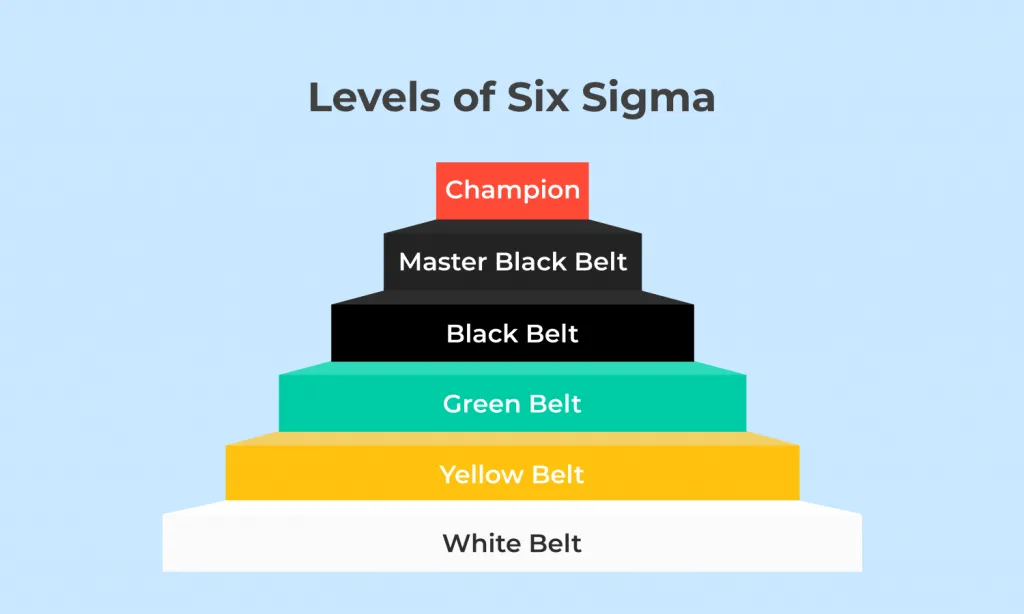So, you are thinking of considering Six Sigma Training, it’s an excellent decision! Even if you have decided on grabbing some for your resume or climbing into a more strategic position, it is one of those certifications that has the potential to really open up and accelerate your career.
There actually are so many of these programs around. Some cheap ones do not have in-depth teaching. Others are loaded with features and quite costly. Which certification is the right one for you, then?
Do not worry. This guide will take you on everything, which is worth knowing before selecting the Best Six Sigma Course credible, practical, and worth your time and money.
What Level of Six Sigma Training Are You Aiming For?

Before you jump into providers, pricing, or platforms, just take a pause. Ask yourself- Where am I starting from? Where do I want to go?
Here is a brief breakout:
- White Belt – For beginners who just want a basic understanding.
- Yellow Belt – Good for supporting small projects to be improved.
- Green Belt – Mainly you handle a small or medium project.
- Black Belt – You will be leading the larger projects and mentoring others.
- Master Black Belt – More on strategy, leadership, and high-level coaching.
If you are new to this space, Lean Six Sigma Green Belt Marketing will allow you to establish your footing in terms of confidence and versatility. You will acquire practical skills without getting wrecked in complex stats.
Six Sigma Training vs. Lean Six Sigma Training: What’s the Real Difference?
- Focus: All about reducing defects and improving quality. Lean Six Sigma does this and eliminates waste, causing time consumed and also speeds up processes.
- Approach: While Six Sigma methodology uses data and statistical tools through the DMAIC method, on the other hand, Lean Six Sigma encompasses all Six Sigma tools along with Lean techniques like 5S and value stream mapping.
- Goal: Six Sigma focuses on improving accuracy. Meanwhile, Lean Six Sigma aims to deliver faster, smoother processes with cost-effective solutions.
- Best For: Industries requiring precision will find Six Sigma best suited (i.e., healthcare, finance). On the other hand, Lean Six Sigma will be of value to fast-moving sectors (i.e., Manufacturing, logistics).
Never Compromise: Choose a Trusted Six Sigma Training Provider
Truth be told, your Six Sigma Certification will stand for as much as the institute backing it. So, how would you know which provider to trust?
- They ought to be accredited (look for ASQ, IASSC, or ISO certifications)
- Trainers should be industry practitioners rather than theorists
- Furthermore, they may include other involved examinations in the course.
- Support should go beyond the course—think career help, mentoring, etc.
Pick a Six Sigma Training Format That Works Best for You
Some people thrive in a classroom setting, while others do their best learning late at night, cozy at home in their pajamas. Most providers nowadays give solutions such as:
- Live online sessions with interaction and Q&A
- Self-paced modules you can revisit anytime
- Hybrid options that combine both styles
- Go with your preferred style of learning
In the end, the main aim should be to learn and understand-be it while completing the course or not.
Six Sigma Training Curriculum: Why It Really Matters?
Not all courses are created equal. Some scratch the surface, while others plunge deep into theory without any relevance to work. These important components form a complete Six Sigma Training program designed for the needs of all:
- Central concepts include DMAIC, or define, measure, analyze, improve, and control. Stat tools (Minitab/Excel)
- Root cause analysis
- Waste reduction and process mapping
- Real-time individual assignments, case studies, practical questions, and previews are included.
- In order to compare various alternatives, ask for further identification, like the syllabus or summary of the subject. If they are unable to produce them, consider this a red flag.
Check Real Six Sigma Training Reviews, Not Just Website Testimonials
Nobody wants to lose money on a subpar course, so do a vacuum check on their credibility before you pay up. There is a need to read beyond their homepage testimonials. Instead, Google for some reviews.
- Track down their alumni on LinkedIn.
- Look for video testimonials or feedback on the courses.
- Ask on forums or in professional groups.
Six Sigma Training Cost: It’s Not Everything, But It Does Matter
Let’s face it: the budget does matter. But mostly, the cheaper course ignores essentials such as live support, exams, or further help after training.
Instead, look at what you really get- If the certification exam is included, if the career support or mentoring is there, if the recorded sessions are after any time, and if the project work is available, you will be able to apply your learning.
Six Sigma Training and Beyond: What Happens After the Course?
This is the part where a lot of learners are stuck. They finish the course and then nothing. Besides this, the first step you may take is evaluating:
- Do they offer internships?
- Can I join a community or alumni group?
- Will they support you with interview prep or help you build a solid Six Sigma project portfolio?
Courses with these add-ons are the ones that actually add to your career growth.
A Top Pick: Henry Harvin

In case you are located in the UAE or searching for a worldwide recognized Six Sigma Training program, then you should definitely consider Henry Harvin. The courses offered by them have a world reputation and they focus on providing training that is practical and hands-on instead of purely theoretical.
The expert trainers who are used to real implementations provide guidance that is knowledgeable as well as relevant to the current work environment.To point out, Henry Harvin is getting a plethora of good reviews for trainer quality, flexible learning styles, and quick student support. That’s huge.
Course Highlights: Six Sigma Certification by Henry Harvin
- Name of Program: Lean Six Sigma Green Belt/Black Belt
- Modes of Learning: Choose either live instructor-led classes or recorded content to pursue your studies at your own pace.
- Hands-on Experience: Learn with more than 12 actual projects and case studies from the industry to strengthen your practical skills.
- Expert Mentors: Get trained through more than ten years of professional experience as industry trainers.
- Certification: Gain a globally accepted certificate that complies with IASSC and ASQ standards.
Henry Harvin offers everything from exam preparation to resume support, and it is absolutely worth it.
Added Benefits
- One-year Gold Membership with recorded sessions
- Internship assistance and live project guidance
- Career and interview support
- Weekly job alerts and soft skill sessions
Best Suited For
Working professionals, engineers, quality analysts, consultants, and management students who want to level up their careers with real, applicable skills, not just a certificate.
Final Conclusion
Choosing the most appropriate Six Sigma Training program is no option for the best or the cheapest course, but the one that fits one’s goals, learning style, and career. Every single step you take from identifying what belt level works for you to selecting a trusted provider like Henry Harvin should be about getting real, very practical results, rather than just another certificate to hang on your wall.
Now, take your time, ask lots of questions, and when you are ready, choose a course that does not simply teach Six Sigma theory but prepares you to actually apply it in the real world.
Recommended Reads
- 10 Benefits of Six Sigma for Operations Management Professionals in 2024
- Top 16 Six Sigma Certification in Delhi: 2025
- Implementing Six Sigma in Your Organization: A Step-by-Step Guide
- Top 20 Six Sigma Black Belt Certification in Dubai in 2025 With Course Fees
- The Role of Six Sigma in Quality Management: Ensuring Excellence
Fast ‘n’ ready FAQ
Ans: Lean Six Sigma isn’t conventional Six Sigma since it has waste and speed improvement, usually part of any Lean activity.
Ans: Definitely, it will enhance your profile, create new job opportunities, and mostly result in fat paychecks.
Ans: There are five: White, Yellow, Green, Black, and Master Black Belt—each one deeper in the aspect regarding leadership scope and depth.
Ans:Depending on the belt level and introductory learning format, most of the programs take from a few weeks to some months.
Ans: Both methods work fine. Online is more flexible, especially if you’re working full-time.
